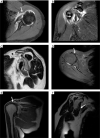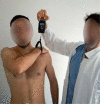Medium- to long-term clinical and functional outcomes of isolated and combined subscapularis tears repaired arthroscopically
- PMID: 34522265
- PMCID: PMC8425253
- DOI: 10.5114/aoms.2020.97714
Medium- to long-term clinical and functional outcomes of isolated and combined subscapularis tears repaired arthroscopically
Abstract
Introduction: The purpose of this study was twofold. First, the efficacy of arthroscopic repair in patients with full thickness, isolated subscapularis tendon tears (I-STTs) or combined subscapularis tendon tears (C-STTs) involving the rotator cuff tendons was evaluated. Second, the outcomes between these two groups were compared. The influence of age and gender on the cohort clinical outcomes was also analysed. Our hypothesis was that satisfactory functional results could be obtained arthroscopically in both groups without any influence of age or gender.
Material and methods: Seventy-nine patients were enrolled: 15 with I-STTs and 64 with C-STTs. The clinical outcomes were assessed using Constant and Disabilities of the Arm, Shoulder and Hand (DASH) scores, Numeric Rating Scale (NRS) for pain and Visual Analogue Scale (VAS) for satisfaction. The subscapularis strength was assessed using a comparative dynamometric bear-hug test. Group outcomes were compared, including statistical analysis.
Results: For each group, there were no differences regarding the subscapularis strength of the operated and non-operated shoulders. A comparison of the post- with the pre-operative outcomes showed an increase in the Constant score and a decrease in the NRS. Comparing the two groups, we found no difference in strength of the operated and non-operated shoulders, but a significant difference in relation to pre-operative Constant score and pre-operative NRS. Age was negatively correlated with both pre-operative and post-operative Constant scores. No association was found between gender and the outcomes, although the DASH score was higher in women.
Conclusions: Arthroscopic repair of STTs provided functional restoration, pain relief and patient satisfaction in both groups. Age and gender did not affect the clinical outcomes achieved by arthroscopic STT repair.
Keywords: Constant score; arthroscopy; rotator cuff; subscapularis repair; subscapularis tendon tears.
Copyright: © 2020 Termedia & Banach.
Conflict of interest statement
The authors declare no conflict of interest.
Figures






Similar articles
-
Comparison of Clinical and Structural Outcomes by Subscapularis Tendon Status in Massive Rotator Cuff Tear.Am J Sports Med. 2017 Sep;45(11):2555-2562. doi: 10.1177/0363546517721187. Epub 2017 Aug 8. Am J Sports Med. 2017. PMID: 28787191
-
Combined Subscapularis Tears in Massive Posterosuperior Rotator Cuff Tears: Do They Affect Postoperative Shoulder Function and Rotator Cuff Integrity?Am J Sports Med. 2016 Jan;44(1):183-90. doi: 10.1177/0363546515610552. Epub 2015 Nov 12. Am J Sports Med. 2016. PMID: 26564791
-
Isolated Subscapularis Repair in Irreparable Posterosuperior Massive Rotator Cuff Tears Involving the Subscapularis Tendon.Am J Sports Med. 2017 May;45(6):1269-1275. doi: 10.1177/0363546516688666. Epub 2017 Mar 20. Am J Sports Med. 2017. PMID: 28318302
-
Subscapularis tears: hidden and forgotten no more.JSES Open Access. 2018 Mar 1;2(1):74-83. doi: 10.1016/j.jses.2017.11.006. eCollection 2018 Mar. JSES Open Access. 2018. PMID: 30675571 Free PMC article. Review.
-
Subscapularis tears.Med Sport Sci. 2012;57:114-121. doi: 10.1159/000328886. Epub 2011 Oct 4. Med Sport Sci. 2012. PMID: 21986050 Review.
Cited by
-
Comparison of Outcomes between Open and Arthroscopic Rotator Cuff Repair.Adv Orthop. 2024 Jan 11;2024:5575404. doi: 10.1155/2024/5575404. eCollection 2024. Adv Orthop. 2024. PMID: 38249956 Free PMC article.
-
Clinical application research on the quantitative measurement of supraspinatus muscle fatty degeneration based on PACS system to improve preoperative assessment.Front Surg. 2025 Jul 2;12:1627901. doi: 10.3389/fsurg.2025.1627901. eCollection 2025. Front Surg. 2025. PMID: 40672441 Free PMC article.
-
Effectiveness of combined extracorporeal shock-wave therapy and hyaluronic acid injections for patients with shoulder pain due to rotator cuff tendinopathy: a person-centered approach with a focus on gender differences to treatment response.BMC Musculoskelet Disord. 2022 Sep 15;23(1):863. doi: 10.1186/s12891-022-05819-3. BMC Musculoskelet Disord. 2022. PMID: 36109717 Free PMC article.
-
Alteration in coracohumeral ligament and distance in people with symptoms of subcoracoid impingement.BMC Musculoskelet Disord. 2023 Jan 23;24(1):58. doi: 10.1186/s12891-023-06152-z. BMC Musculoskelet Disord. 2023. PMID: 36683027 Free PMC article.
-
Analysis of risk factors for advanced age in patients with frozen shoulder.Aging Clin Exp Res. 2023 Mar;35(3):615-620. doi: 10.1007/s40520-023-02347-5. Epub 2023 Feb 1. Aging Clin Exp Res. 2023. PMID: 36723857
References
-
- Keating JF, Waterworth P, Shaw-Dunn J, Crossan J. The relative strengths of the rotator cuff muscles. A cadaver study. J Bone Joint Surg Br. 1993;75:137–40. - PubMed
-
- Deutsch A, Altchek DW, Veltri DM, Potter HG, Warren RF. Traumatic tears of the subscapularis tendon. Clinical diagnosis, magnetic resonance imaging findings, and operative treatment. Am J Sports Med. 1997;25:13–22. - PubMed
-
- Arai R, Sugaya H, Mochizuki T, Nimura A, Moriishi J, Akita K. Subscapularis tendon tear: an anatomic and clinical investigation. Arthroscopy. 2008;24:997–1004. - PubMed
-
- Adams CR, Schoolfield JD, Burkhart SS. Accuracy of pre-operative magnetic resonance imaging in predicting a subscapularis tendon tear based on arthroscopy. Arthroscopy. 2010;26:1427–33. - PubMed
LinkOut - more resources
Full Text Sources
